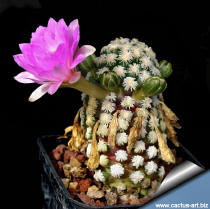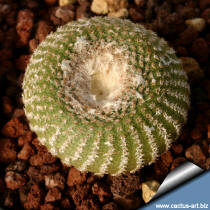|

Mammillaria theresae

Yavia cryptocarpa |
This type of fruit are
characteristic of few sort of
cactus , for example
Mammillaria of the
Series Longiflorae (e.g.
M. theresae, M. saboae, …) and
Yavia cryptocarpa.
They are retained within the plant body for several
years or for the whole
life cycle of the plant, and
frequently (in Mammillaria) the
fruit and
seeds will be released only at the
death of the plant after the
disintegration of the old stem.
After the
flower is finished and dropped off, the
stem
closes over the fruit and the fruit/seed slowly
ripens within. The next year, or
years, the fruit may remain within
the body at the axil, or may poke
out a bit.
Seeds
of cryptocarpic species
are equipped to
maintain their
vitality for many years, they contain
inhibitors that preserve them from
premature
germination, generally
fresh seeds won’t germinate very
well, only old seeds do.
It is possible to collect
fruit and seeds from this plants only by means of a thin pointed
forceps. The complete
germination of this kind of seeds may take several years
(occasionally a seed will sprout unexpectedly after 5 or 8 years!)
Because of the above peculiarity, seed of
cryptocarpic Mammillaria (Series Longiflorae) is seldom available
from commercial sources, as its
collection is unusually labour intensive. In
Yavia the ripen fruit will
be slowly expelled by the
growing of the plant during the
humid season when the plant body
swell up.
|